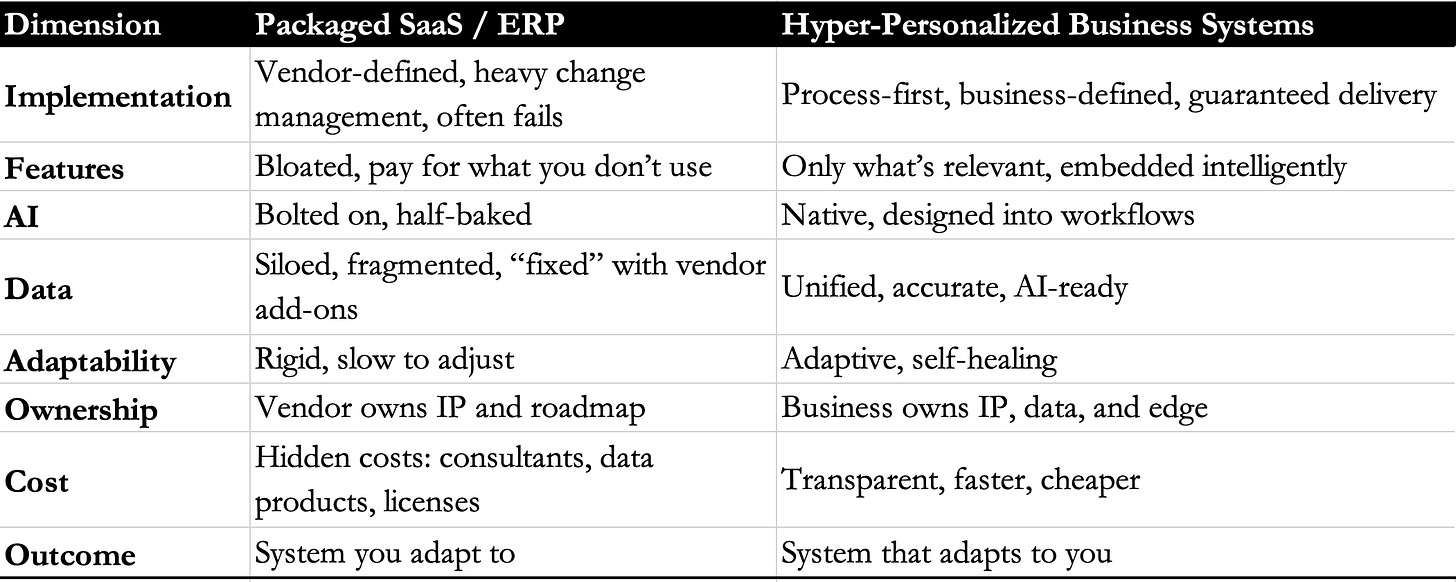Introduction: Why We’re Still Running on Glue
Every decade or so, a new generation of business software arrives with the promise of finally fixing the chaos.
In the 90s, ERP systems promised to unify the enterprise.
In the 2000s, SaaS promised to deliver agility and simplicity.
In the 2010s, cloud-first and “digital transformation” promised to free businesses from legacy.
Now, in the 2020s, every vendor promises AI.
And yet—walk into almost any business today, and you’ll find the same story:
The ERP or SaaS suite runs the “core,” but never everything.
Around it lives an ecosystem of spreadsheets, Access databases, small custom apps, and duct-taped workflows.
Data is spread across silos, duplicated in different tools, or just plain stale.
“Visibility” comes from manual reporting, not the system itself.
The glue holding it all together isn’t software. It’s people—managers manually reconciling data, analysts stitching spreadsheets, operations leaders constantly firefighting.
The irony? The very software that promised to reduce complexity has, in many cases, multiplied it.
It’s time for a new paradigm: Hyper-Personalized Business Systems.
Why Legacy SaaS and ERP Keep Failing
The failures of packaged business software aren’t just inconveniences. They’ve become structural barriers to growth, efficiency, and competitiveness. Let’s unpack why.
1. The Glue Problem
Every ERP or SaaS suite eventually runs into gaps. An ERP might cover finance and inventory, but not the quirks of your logistics operation. A CRM might manage sales pipelines, but not the unique workflows of your account managers.
What fills those gaps? Spreadsheets. Access databases. Custom SharePoint workflows. “Shadow IT.”
Example:
A mid-sized distributor runs SAP Business One for finance and inventory. But their rebate management is so specific that SAP can’t handle it without a custom module. Instead, the finance team maintains three massive Excel files that calculate rebates, export data weekly from SAP, and manually reconcile everything.
The result: errors, delays, and risk. The “core system” doesn’t actually run the business—it just handles part of it.
2. Feature Fatigue
Packaged systems sell on breadth: “We have 400 features, so we can cover any business.” The reality is that most companies use less than 20 percent of what they’re paying for.
Worse, the features they do need are either:
Not flexible enough for their unique processes, or
Locked behind expensive customization and consulting projects.
Example:
A services company adopts NetSuite. Out of the box, it covers finance and resource planning. But they need project-specific margin tracking. NetSuite has a “projects” module, but it’s designed for consulting firms, not field services. They spend $200,000 on customization—only to end up with something clunky that still requires spreadsheets for reporting.
3. AI as an Afterthought
Vendors are now rushing to market with “AI-powered” features. But most are shallow add-ons: predictive text in a CRM, auto-tagging in an ERP, or chatbots bolted on for support.
The deeper problem: AI requires clean, unified, accessible data. Legacy SaaS systems can’t provide that because they themselves created siloes. Vendors now sell “data products” (data lakes, ETL pipelines, analytics dashboards) as the solution to the mess their platforms created.
Example:
A retailer runs Oracle NetSuite for ERP, Salesforce for CRM, and Workday for HR. None of the systems talk natively. The vendor’s solution? Buy an “integration hub,” plus a “data lake,” plus a subscription to their “analytics cloud.” The company ends up buying three new products just to see the same data in one place.
AI is useless on top of fragmented data. Garbage in, garbage out.
4. Implementation and Training Traps
SaaS is sold as “plug and play.” In practice, every implementation becomes a semi-custom project:
Migrations run long.
Change management drags on.
Adoption falters.
The result: businesses invest millions, only to end up with systems that are just as fragile and customized as the “old” world of on-prem software.
Example:
A manufacturing firm buys Dynamics 365. The vendor promises a six-month rollout. Two years later, they’re still paying consultants to get the system to reflect how their shop floor actually works. The original “out-of-the-box” simplicity has disappeared.
5. Rigidity vs. Change
Business is constant change: new regulations, new business models, new customer expectations. Legacy systems are built to be stable, not adaptive.
When processes change faster than systems can adapt, what fills the gap? Again: spreadsheets.
Example:
A logistics company expands into cold-chain transport. Their ERP can’t handle temperature-sensitive tracking without an expensive customization project. Instead, the ops team builds a Google Sheet to track deliveries manually until “the ERP catches up.” It never does.
The Endless Cycle of “Data Products”
Here’s the cruel irony: the same vendors who created this fragmentation then sell businesses the tools to fix it.
ERP vendors sell ETL tools to extract data from their own systems.
CRM vendors sell analytics clouds to reconcile what their platform can’t report.
SaaS vendors sell data lakes to unify what they fragmented in the first place.
It’s like selling someone a leaking bucket, then selling them a mop, then selling them a subscription to “Mop-as-a-Service.”
Example:
The core CRM leaves gaps in reporting and workflow, so the CRM vendor pushes Tableau, MuleSoft, and “Einstein AI” as fixes. Each is another product, another license, another bill. Businesses end up paying more to compensate for the deficiencies of the system they already bought.
The Case for Hyper-Personalized Business Systems
Hyper-personalized systems flip the paradigm. Instead of buying someone else’s bloated package and bending your business to fit it, you design systems that fit your business.
Principles of Hyper-Personalization:
Process-first, tech-second – Refine workflows before digitizing them.
Relevant best practices only – Embed industry-proven methods where they add value, skip the bloat.
Native automation and AI – Design intelligence into workflows from the start, not as a bolt-on.
Unified by design – Eliminate the glue—no more spreadsheets, shadow IT, or endless integrations.
Adaptive and self-healing – Systems that evolve as the business evolves, instead of breaking every time it changes.
Ownership – Businesses keep the IP and data. No vendor lock-in, no rented processes.
Illustrative Scenarios
Scenario 1: The Growing Services Firm
Today: Runs QuickBooks + HubSpot + spreadsheets. As they grow, leadership considers NetSuite.
Problem: NetSuite offers dozens of features, but the firm only needs project accounting, client visibility, and resource planning. Customization adds cost.
Hyper-Personalized Approach: Build a lean system embedding just those capabilities, with automation for invoicing and native AI for forecasting. No bloat, no consultants, live in 4 months.
Scenario 2: The Multi-Plant Manufacturer
Today: SAP handles finance, but shop floor reporting happens in Excel. Data is stale, visibility poor.
Problem: SAP promises “shop floor modules” but they require 12 months of consulting.
Hyper-Personalized Approach: Unify data around SAP, eliminate Excel with a tailored production reporting layer, embed process optimization. Real-time visibility achieved without replacing ERP.
Scenario 3: The PE-Backed Roll-Up
Today: Portfolio companies run a patchwork of ERPs and CRMs. Roll-up synergies are blocked by system siloes.
Problem: Consolidating onto one ERP would take years and millions.
Hyper-Personalized Approach: Create a unification layer around existing systems, eliminate spreadsheets, unify data, and introduce AI-driven reporting across the portfolio. Faster, cheaper, scalable.
From Cost Center to Competitive Edge
Hyper-personalized systems are not just about efficiency. They’re about strategy.
Own your IP. Unique workflows are part of your competitive edge. With SaaS, you rent them. With hyper-personalized systems, you own them.
Own your data. Data is the raw material for AI. Fragmented data is worthless. Unified data is priceless.
Own your edge. Systems that fit your business become part of your moat—impossible for competitors to replicate with off-the-shelf software.
The Future: Adaptive and Self-Healing Systems
The next horizon is adaptive, self-healing platforms:
Systems that auto-diagnose when a workflow breaks.
Systems that self-adjust when regulations change.
Systems that recommend optimizations proactively, not reactively.
This isn’t science fiction—it’s the logical outcome of building hyper-personalized foundations. Once you own the process and data, adaptive intelligence can continuously refine it.
Closing Thought
Businesses have been trapped in the old paradigm for too long. Packaged software delivered rigidity and hidden costs. Custom development was too slow and risky.
Hyper-personalized business systems are the new paradigm.
They embed only what matters, eliminate the glue, unify the stack, and make businesses AI-ready.
Not rented software. Not bloated packages. Not fragile spreadsheets.
Just business systems that fit your business—and grow with it.









